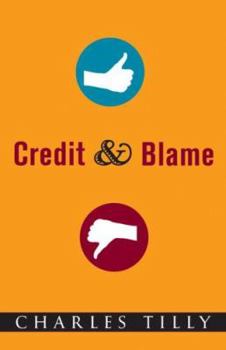Credit and Blame
Select Format
Select Condition 
Book Overview
In his eye-opening book Why?, world-renowned social scientist Charles Tilly exposed some startling truths about the excuses people make and the reasons they give. Now he's back with further explorations into the complexities of human relationships, this time examining what's really going on when we assign credit or cast blame.
Everybody does it, but few understand the hidden motivations behind it. With his customary wit and dazzling insight, Tilly takes a lively and thought-provoking look at the ways people fault and applaud each other and themselves. The stories he gathers in Credit and Blame range from the everyday to the altogether unexpected, from the revealingly personal to the insightfully humorous--whether it's the gushing acceptance speech of an Academy Award winner or testimony before a congressional panel, accusations hurled in a lover's quarrel or those traded by nations in a post-9/11 crisis, or a job promotion or the Nobel Prize. Drawing examples from literature, history, pop culture, and much more, Tilly argues that people seek not only understanding through credit and blame, but also justice. The punishment must fit the crime, accomplishments should be rewarded, and the guilty parties must always get their just deserts. Brilliantly conceived and masterfully written, Credit and Blame is a book that revolutionizes our understanding of the compliments we pay and the accusations we make.Format:Hardcover
Language:English
ISBN:0691135789
ISBN13:9780691135786
Release Date:May 2008
Publisher:Princeton University Press
Length:196 Pages
Weight:0.90 lbs.
Dimensions:0.8" x 6.0" x 8.8"
Customer Reviews
1 rating
A readable and remarkable primer in the social science of crediting and blaming
Published by Thriftbooks.com User , 16 years ago
This book is written by a very eminent sociologist from Princeton University. What Professor Tilly offers in this engrossing book is a primer in the social science of crediting and blaming. The key objective of this book is to explain "how" humans assign credit and blame to other people's actions as well as their own. According to Professor Tilly, humans have to take full responsibility for their social actions and crediting and blaming are fundamentally social acts. The acts of crediting and blaming usually embrace standards of justice in which humans can relate awards and punishments to good and bad actions. In assigning credit or blame, humans are making judgments of outcome, agency, competence, and responsibility of an action. Chapter 2 of the book presents a justice detector to multiply scores for outcome, agency, competence, and responsibility so that credit or blame of an action can be computed. A person can get all the credit if his/her total score is +1 whereas he or she takes on huge blame if his/her total score is -1 (P.36). In Chapter 3 and Chapter 4, Professor Tilly illustrates the assignment of credit and blame to other people's actions and their own with abundant vivid stories and his trenchant observations. In giving credit, people have invented four different ways of fitting credit elements together including tournaments, honors, promotions, and networks (P.65). Besides the level of performance people who can get all the credit, Professor Tilly further maintains that different ways of assigning credits are predicated upon local rules, gossip, social pressure, and moral discussion so that the awarding of credit can be more contentious than the assignment of blame (P.58). In blame, the "us-them" boundary is more conspicuous than credit since humans tend to establish a sharp line between blamers and the so-called perpetrators (P.103). Chapter 4 depicts how people put blame on different controversial legal and political issues such as culpable negligence, harm to children, drug-related crime, and responsibility for the 9/11 terror attacks. Professor Tilly explains five different ways for blamers to demand justice including contingent retaliation, incapacitation, deterrence, rehabilitation, and restoration. In the last chapter, Professor Tilly displays the interaction of credit and blame in war memorials and ratings of political leaders in the US and Latin America. Ostensibly a book aimed at readers who are interested in human judgment and behavior, Credit and Blame makes readers view credit and blame with more critical eyes.





